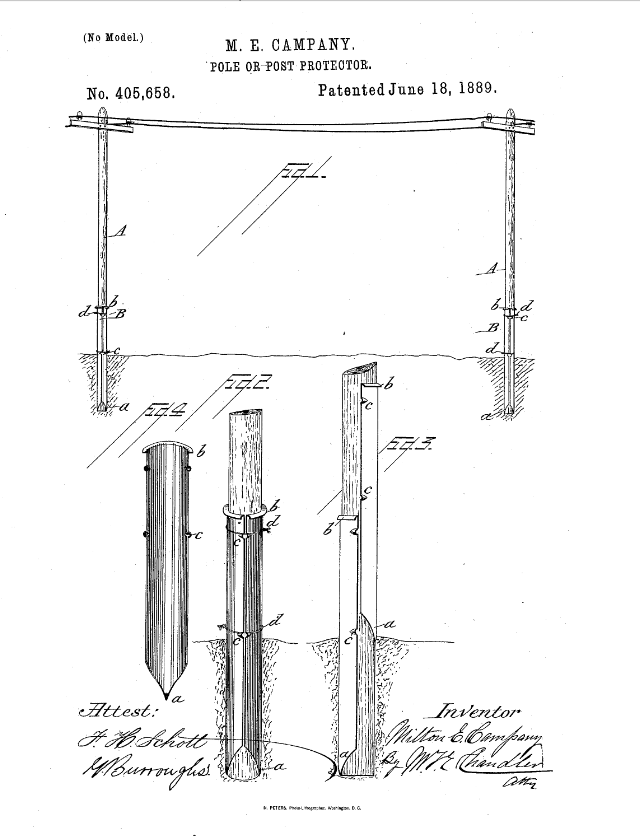MILTON E. CAMPANY, OF HAMILTON, ASSIGNOR OF ONE-HALF TO HORACE B. PECK,
OF ALLEGAN MICHIGAN
POLE AND POST PROTECTOR.
SPECIFICATION forming part of Letters Patent No. 405,658,
dated June 18, 1889.
Application filed February 11, 1889. Serial No. 299,412. (No model.)
To all whom it may concern:
Be it known that I, MILTON E. CAMPANY, a citizen of the United
States, residing at Hamilton, in the county of Allegan and State of Michigan, have invented certain new and
useful Improvements in Pole or Post Protectors; and I do declare the following to be a full, clear,
and exact description of the
invention, such as will enable others skilled in the art to
which it appertains to make and use the same, reference being had to
the accompanying drawings, and to the letters and figures of reference marked thereon, which form a part
of this specification.
This invention relates especially to a post support and protector designed more particularly
for the protection and support of
telegraph and telephone poles, or posts used for other purposes, the object beiing to stiffen the same near their lower ends where
they emerge from the ground, and protect them from decay at that point. It being well known that this is the portion of the pole
most exposed to the effects of heat and moisture, it begins to decal first, and the pole is frequently rendered useless by its
becoming so much decayed at the surface of the ground as to break at that point when it is exposed to wind or other strains, thus
destroying the pole, which in other respects is still valuable.
The usefulness of this support and protector is not
alone in its application to new poles, but it may be readily applied to those which have already become dangerous from decay at this
point, strengthening and increasing the durability of the same to a freat extent.
In preparing and applying this protector
or support elongated sheets of metal of such width as when bent into a curve will encircle nearly or quite on-half of the pole, and of
sufficient thickness to give the requisite strength, are bent lengthwise to a curve approaching a semicircle, thus forming on-half of
a tube split longitudinally. One end of these pieces may be tapered to enable it to penetrate the earth with less difficulty, and the
other end turned outward, forming a flange which not only stiffens the protector, but affords means for readily applying a force by which
it is to be driven into position alongside the pole or post.
The application of this support and protector is made by
applying two of them, one upon each side of the pole or post, and driving them down into the earth for about one-half their length.
For and ordinary telegraph-pole they may be five or six feet in length, thus when driven down projecting some three feet above the
surface. This upwardly - projecting part is then securely clamped to the pole by wire or other metallic clamps passing around the same
and firmly secured. If desired, the spaces between the support and pole may be filled with coal-tar, melted pitch, or other similar
material, to prevent water from entering the space between the protector and the pole, thus preventing decay of the same. The metal
of which the protector is formed may be galvanized or otherwise protected from oxidation by exposure to the weather.
In the accompanying drawings, which illustrate this invention, Figure 1 shows a telegraph-line with the poles supported by these
protectos. Fig. 2 shows a single post, upon an enlarged scale, with the protector and clamp in position. Fig. 3 shows a pole with
one protector driven down to place and the other in position for driving. Fig. 4 is a perspective view showing the construction of the
protector.
In the several figures, A represents a telegraph pole or poles to be supported, and B are the protectors. As will
be seen, each of these protectors is formed from a sheet of metal of sufficient length with one end tapered to a point a like a pen,
the sheet being then bent to nearly a semicircle, and having at the end opposite the taper a flange b turned outwardly. At suitable
points to receive the clamps a depression is formed in the metal of the protector, producing a slight projection c, which prevents
the clamps d from falling down after they are placed in position. These clamps d may be formed in various ways, a simple
and cheap construction being to use a piece of wire which is bent around the protectors and its ends twisted together until they cause
the parts of the protector to firmly hug the post; or they may be made of band-iron or other suitable material, placed in position, and
secured by screws or rivets. (more information available on the patent application)
In testimony whereof I have signed my name to this specification
in the presence of two subscribing witnesses.MILTON E. CAMPANY.
Witnesses:
MATE S. WILLIAMS,
HIRAM C. STREETER.
|
 Click to enlarge
Click to enlarge
image from patent
application |




 Return
To Home Page
Return
To Home Page
